Understanding Australian Indigenous Contexts & Education: An Essay
VerifiedAdded on 2022/08/24
|8
|2004
|28
Essay
AI Summary
This essay provides a comprehensive overview of Australian Indigenous contexts and education, exploring the rich history, culture, and social structures of Aboriginal people. It begins with a historical context, discussing the long-standing presence of Aboriginal clans in Australia and the impact of European colonization. The essay highlights key aspects of Aboriginal culture, including oral storytelling, dreamtime stories, sacred sites, ceremonies, and the importance of kinship and social organization. It also examines Aboriginal business and economic contributions. Furthermore, the essay applies Pierre Bourdieu's sociological theories to analyze Aboriginal social concepts, focusing on habitus, capital, and power relations. The author emphasizes the significance of understanding cultural elements and addressing inequalities. The essay concludes by advocating for the recognition and acceptance of Aboriginal culture in a multicultural society. References to relevant sources are included throughout the essay.
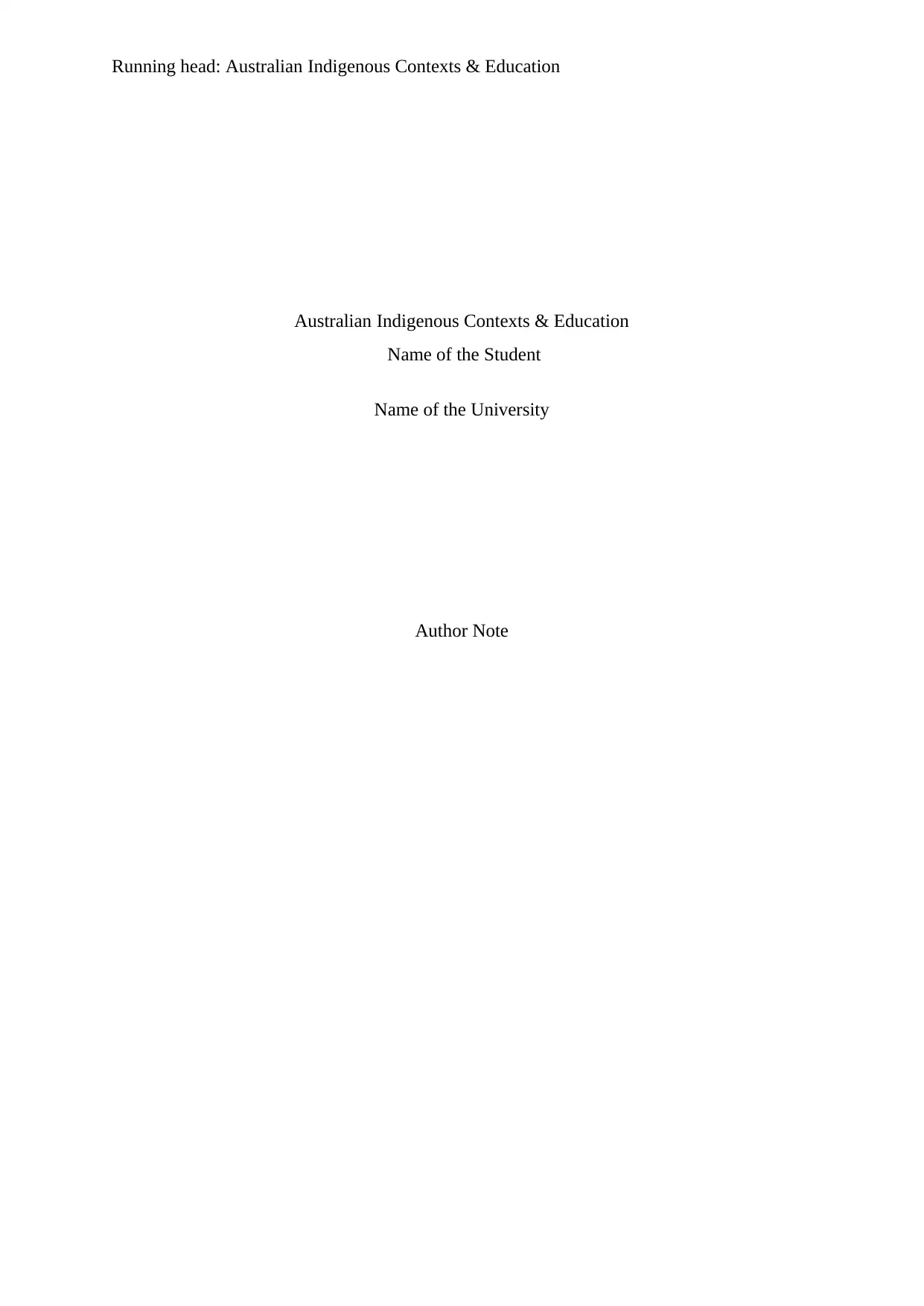
Running head: Australian Indigenous Contexts & Education
Australian Indigenous Contexts & Education
Name of the Student
Name of the University
Author Note
Australian Indigenous Contexts & Education
Name of the Student
Name of the University
Author Note
Paraphrase This Document
Need a fresh take? Get an instant paraphrase of this document with our AI Paraphraser
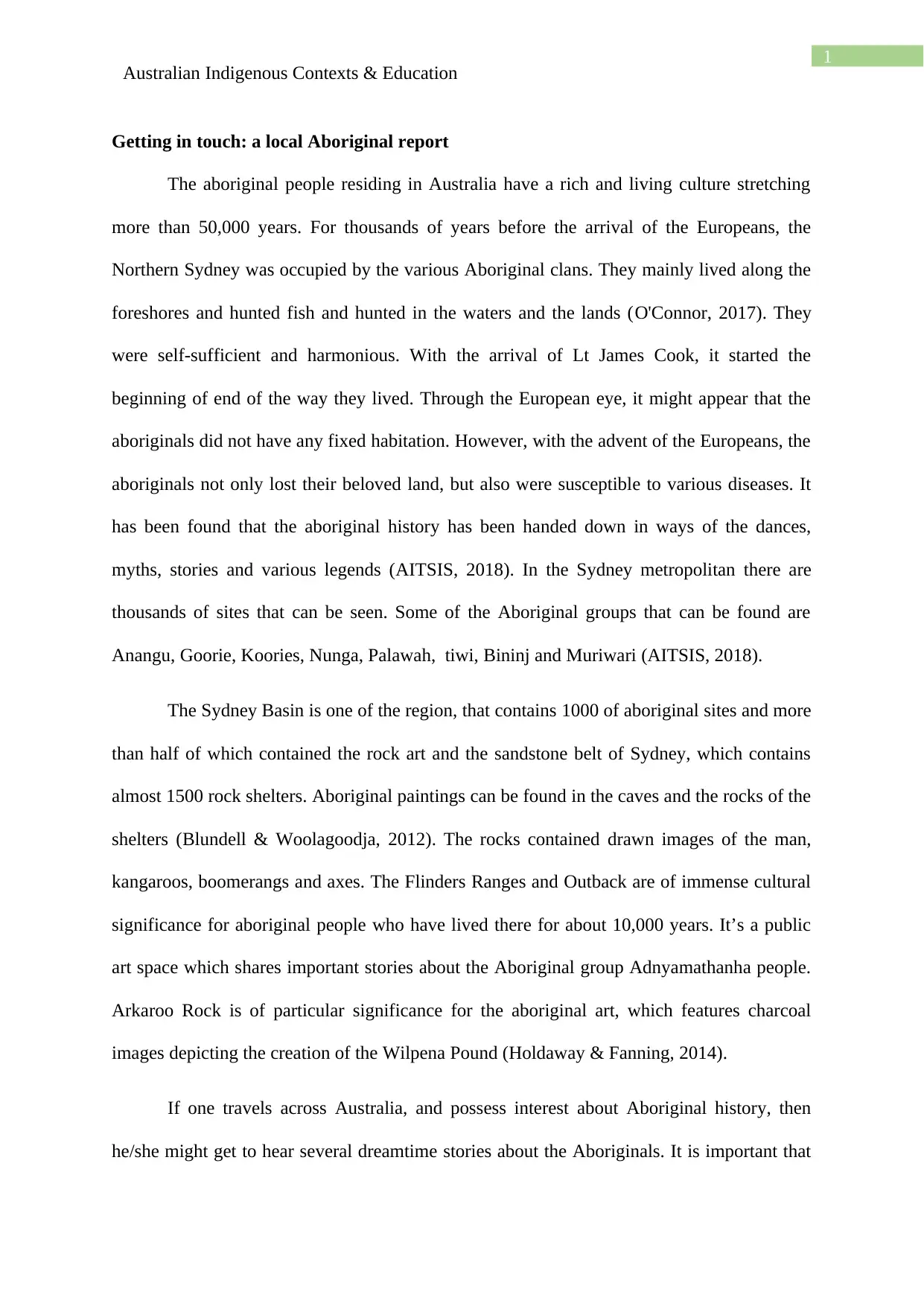
1
Australian Indigenous Contexts & Education
Getting in touch: a local Aboriginal report
The aboriginal people residing in Australia have a rich and living culture stretching
more than 50,000 years. For thousands of years before the arrival of the Europeans, the
Northern Sydney was occupied by the various Aboriginal clans. They mainly lived along the
foreshores and hunted fish and hunted in the waters and the lands (O'Connor, 2017). They
were self-sufficient and harmonious. With the arrival of Lt James Cook, it started the
beginning of end of the way they lived. Through the European eye, it might appear that the
aboriginals did not have any fixed habitation. However, with the advent of the Europeans, the
aboriginals not only lost their beloved land, but also were susceptible to various diseases. It
has been found that the aboriginal history has been handed down in ways of the dances,
myths, stories and various legends (AITSIS, 2018). In the Sydney metropolitan there are
thousands of sites that can be seen. Some of the Aboriginal groups that can be found are
Anangu, Goorie, Koories, Nunga, Palawah, tiwi, Bininj and Muriwari (AITSIS, 2018).
The Sydney Basin is one of the region, that contains 1000 of aboriginal sites and more
than half of which contained the rock art and the sandstone belt of Sydney, which contains
almost 1500 rock shelters. Aboriginal paintings can be found in the caves and the rocks of the
shelters (Blundell & Woolagoodja, 2012). The rocks contained drawn images of the man,
kangaroos, boomerangs and axes. The Flinders Ranges and Outback are of immense cultural
significance for aboriginal people who have lived there for about 10,000 years. It’s a public
art space which shares important stories about the Aboriginal group Adnyamathanha people.
Arkaroo Rock is of particular significance for the aboriginal art, which features charcoal
images depicting the creation of the Wilpena Pound (Holdaway & Fanning, 2014).
If one travels across Australia, and possess interest about Aboriginal history, then
he/she might get to hear several dreamtime stories about the Aboriginals. It is important that
Australian Indigenous Contexts & Education
Getting in touch: a local Aboriginal report
The aboriginal people residing in Australia have a rich and living culture stretching
more than 50,000 years. For thousands of years before the arrival of the Europeans, the
Northern Sydney was occupied by the various Aboriginal clans. They mainly lived along the
foreshores and hunted fish and hunted in the waters and the lands (O'Connor, 2017). They
were self-sufficient and harmonious. With the arrival of Lt James Cook, it started the
beginning of end of the way they lived. Through the European eye, it might appear that the
aboriginals did not have any fixed habitation. However, with the advent of the Europeans, the
aboriginals not only lost their beloved land, but also were susceptible to various diseases. It
has been found that the aboriginal history has been handed down in ways of the dances,
myths, stories and various legends (AITSIS, 2018). In the Sydney metropolitan there are
thousands of sites that can be seen. Some of the Aboriginal groups that can be found are
Anangu, Goorie, Koories, Nunga, Palawah, tiwi, Bininj and Muriwari (AITSIS, 2018).
The Sydney Basin is one of the region, that contains 1000 of aboriginal sites and more
than half of which contained the rock art and the sandstone belt of Sydney, which contains
almost 1500 rock shelters. Aboriginal paintings can be found in the caves and the rocks of the
shelters (Blundell & Woolagoodja, 2012). The rocks contained drawn images of the man,
kangaroos, boomerangs and axes. The Flinders Ranges and Outback are of immense cultural
significance for aboriginal people who have lived there for about 10,000 years. It’s a public
art space which shares important stories about the Aboriginal group Adnyamathanha people.
Arkaroo Rock is of particular significance for the aboriginal art, which features charcoal
images depicting the creation of the Wilpena Pound (Holdaway & Fanning, 2014).
If one travels across Australia, and possess interest about Aboriginal history, then
he/she might get to hear several dreamtime stories about the Aboriginals. It is important that
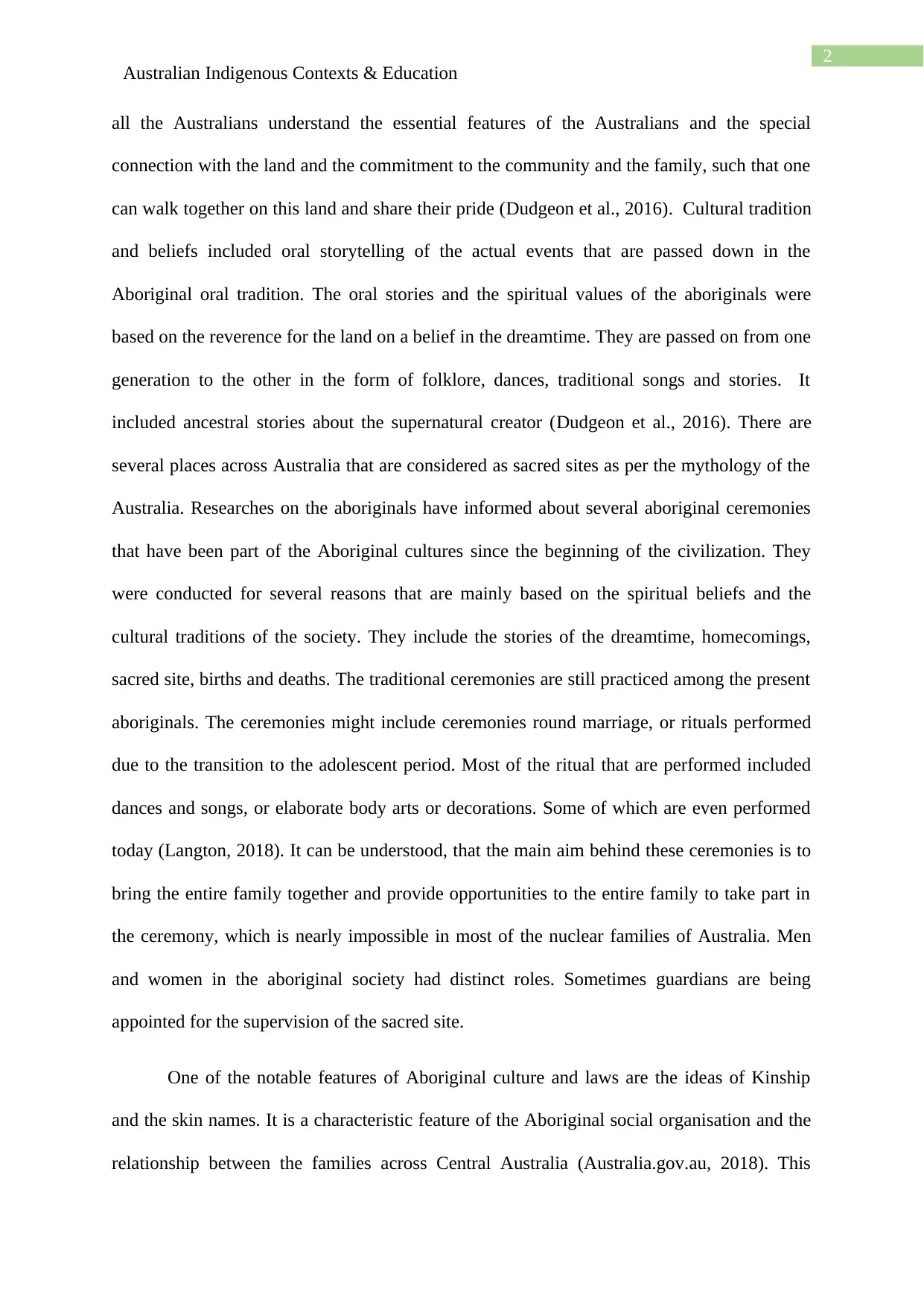
2
Australian Indigenous Contexts & Education
all the Australians understand the essential features of the Australians and the special
connection with the land and the commitment to the community and the family, such that one
can walk together on this land and share their pride (Dudgeon et al., 2016). Cultural tradition
and beliefs included oral storytelling of the actual events that are passed down in the
Aboriginal oral tradition. The oral stories and the spiritual values of the aboriginals were
based on the reverence for the land on a belief in the dreamtime. They are passed on from one
generation to the other in the form of folklore, dances, traditional songs and stories. It
included ancestral stories about the supernatural creator (Dudgeon et al., 2016). There are
several places across Australia that are considered as sacred sites as per the mythology of the
Australia. Researches on the aboriginals have informed about several aboriginal ceremonies
that have been part of the Aboriginal cultures since the beginning of the civilization. They
were conducted for several reasons that are mainly based on the spiritual beliefs and the
cultural traditions of the society. They include the stories of the dreamtime, homecomings,
sacred site, births and deaths. The traditional ceremonies are still practiced among the present
aboriginals. The ceremonies might include ceremonies round marriage, or rituals performed
due to the transition to the adolescent period. Most of the ritual that are performed included
dances and songs, or elaborate body arts or decorations. Some of which are even performed
today (Langton, 2018). It can be understood, that the main aim behind these ceremonies is to
bring the entire family together and provide opportunities to the entire family to take part in
the ceremony, which is nearly impossible in most of the nuclear families of Australia. Men
and women in the aboriginal society had distinct roles. Sometimes guardians are being
appointed for the supervision of the sacred site.
One of the notable features of Aboriginal culture and laws are the ideas of Kinship
and the skin names. It is a characteristic feature of the Aboriginal social organisation and the
relationship between the families across Central Australia (Australia.gov.au, 2018). This
Australian Indigenous Contexts & Education
all the Australians understand the essential features of the Australians and the special
connection with the land and the commitment to the community and the family, such that one
can walk together on this land and share their pride (Dudgeon et al., 2016). Cultural tradition
and beliefs included oral storytelling of the actual events that are passed down in the
Aboriginal oral tradition. The oral stories and the spiritual values of the aboriginals were
based on the reverence for the land on a belief in the dreamtime. They are passed on from one
generation to the other in the form of folklore, dances, traditional songs and stories. It
included ancestral stories about the supernatural creator (Dudgeon et al., 2016). There are
several places across Australia that are considered as sacred sites as per the mythology of the
Australia. Researches on the aboriginals have informed about several aboriginal ceremonies
that have been part of the Aboriginal cultures since the beginning of the civilization. They
were conducted for several reasons that are mainly based on the spiritual beliefs and the
cultural traditions of the society. They include the stories of the dreamtime, homecomings,
sacred site, births and deaths. The traditional ceremonies are still practiced among the present
aboriginals. The ceremonies might include ceremonies round marriage, or rituals performed
due to the transition to the adolescent period. Most of the ritual that are performed included
dances and songs, or elaborate body arts or decorations. Some of which are even performed
today (Langton, 2018). It can be understood, that the main aim behind these ceremonies is to
bring the entire family together and provide opportunities to the entire family to take part in
the ceremony, which is nearly impossible in most of the nuclear families of Australia. Men
and women in the aboriginal society had distinct roles. Sometimes guardians are being
appointed for the supervision of the sacred site.
One of the notable features of Aboriginal culture and laws are the ideas of Kinship
and the skin names. It is a characteristic feature of the Aboriginal social organisation and the
relationship between the families across Central Australia (Australia.gov.au, 2018). This
⊘ This is a preview!⊘
Do you want full access?
Subscribe today to unlock all pages.

Trusted by 1+ million students worldwide
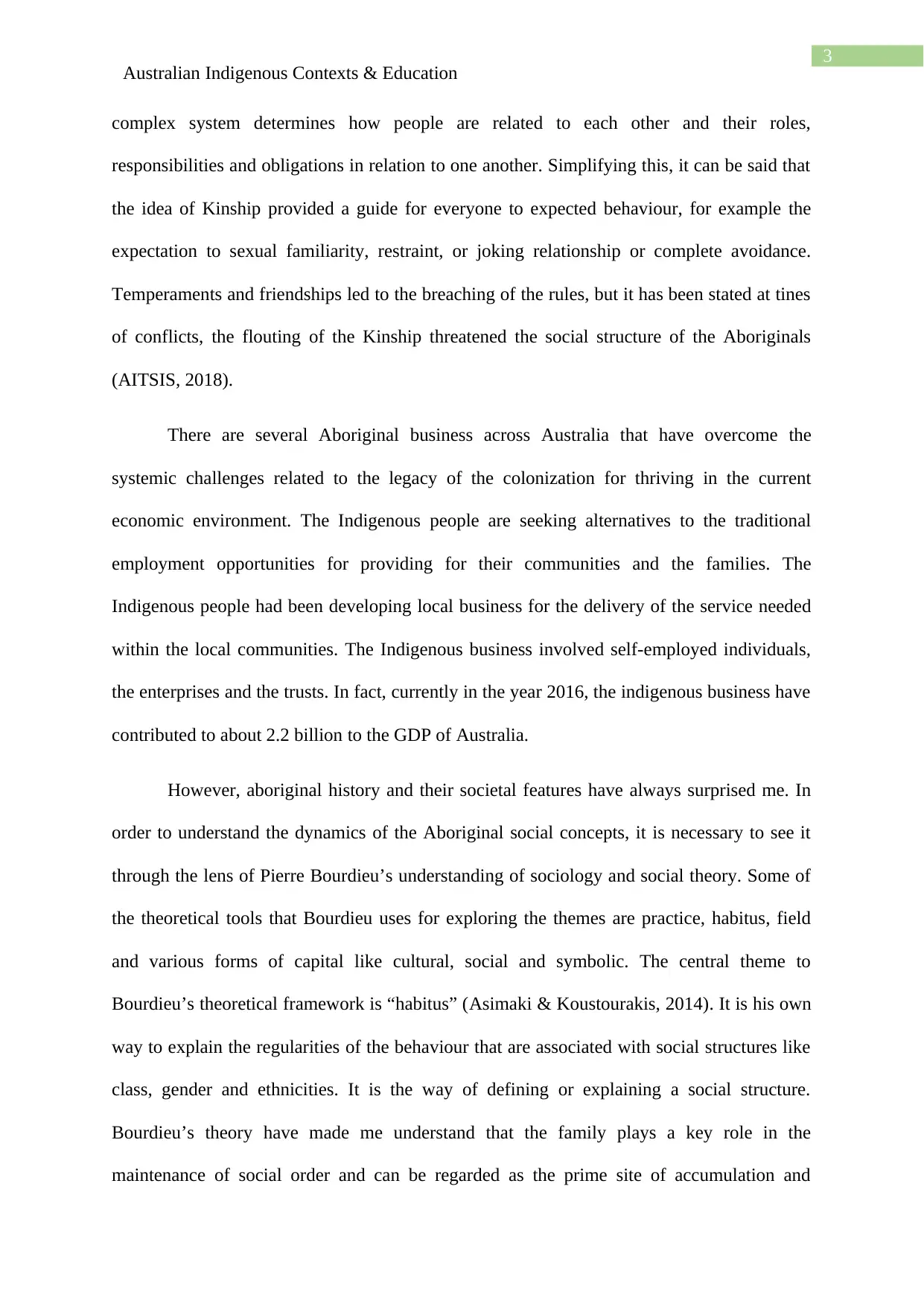
3
Australian Indigenous Contexts & Education
complex system determines how people are related to each other and their roles,
responsibilities and obligations in relation to one another. Simplifying this, it can be said that
the idea of Kinship provided a guide for everyone to expected behaviour, for example the
expectation to sexual familiarity, restraint, or joking relationship or complete avoidance.
Temperaments and friendships led to the breaching of the rules, but it has been stated at tines
of conflicts, the flouting of the Kinship threatened the social structure of the Aboriginals
(AITSIS, 2018).
There are several Aboriginal business across Australia that have overcome the
systemic challenges related to the legacy of the colonization for thriving in the current
economic environment. The Indigenous people are seeking alternatives to the traditional
employment opportunities for providing for their communities and the families. The
Indigenous people had been developing local business for the delivery of the service needed
within the local communities. The Indigenous business involved self-employed individuals,
the enterprises and the trusts. In fact, currently in the year 2016, the indigenous business have
contributed to about 2.2 billion to the GDP of Australia.
However, aboriginal history and their societal features have always surprised me. In
order to understand the dynamics of the Aboriginal social concepts, it is necessary to see it
through the lens of Pierre Bourdieu’s understanding of sociology and social theory. Some of
the theoretical tools that Bourdieu uses for exploring the themes are practice, habitus, field
and various forms of capital like cultural, social and symbolic. The central theme to
Bourdieu’s theoretical framework is “habitus” (Asimaki & Koustourakis, 2014). It is his own
way to explain the regularities of the behaviour that are associated with social structures like
class, gender and ethnicities. It is the way of defining or explaining a social structure.
Bourdieu’s theory have made me understand that the family plays a key role in the
maintenance of social order and can be regarded as the prime site of accumulation and
Australian Indigenous Contexts & Education
complex system determines how people are related to each other and their roles,
responsibilities and obligations in relation to one another. Simplifying this, it can be said that
the idea of Kinship provided a guide for everyone to expected behaviour, for example the
expectation to sexual familiarity, restraint, or joking relationship or complete avoidance.
Temperaments and friendships led to the breaching of the rules, but it has been stated at tines
of conflicts, the flouting of the Kinship threatened the social structure of the Aboriginals
(AITSIS, 2018).
There are several Aboriginal business across Australia that have overcome the
systemic challenges related to the legacy of the colonization for thriving in the current
economic environment. The Indigenous people are seeking alternatives to the traditional
employment opportunities for providing for their communities and the families. The
Indigenous people had been developing local business for the delivery of the service needed
within the local communities. The Indigenous business involved self-employed individuals,
the enterprises and the trusts. In fact, currently in the year 2016, the indigenous business have
contributed to about 2.2 billion to the GDP of Australia.
However, aboriginal history and their societal features have always surprised me. In
order to understand the dynamics of the Aboriginal social concepts, it is necessary to see it
through the lens of Pierre Bourdieu’s understanding of sociology and social theory. Some of
the theoretical tools that Bourdieu uses for exploring the themes are practice, habitus, field
and various forms of capital like cultural, social and symbolic. The central theme to
Bourdieu’s theoretical framework is “habitus” (Asimaki & Koustourakis, 2014). It is his own
way to explain the regularities of the behaviour that are associated with social structures like
class, gender and ethnicities. It is the way of defining or explaining a social structure.
Bourdieu’s theory have made me understand that the family plays a key role in the
maintenance of social order and can be regarded as the prime site of accumulation and
Paraphrase This Document
Need a fresh take? Get an instant paraphrase of this document with our AI Paraphraser
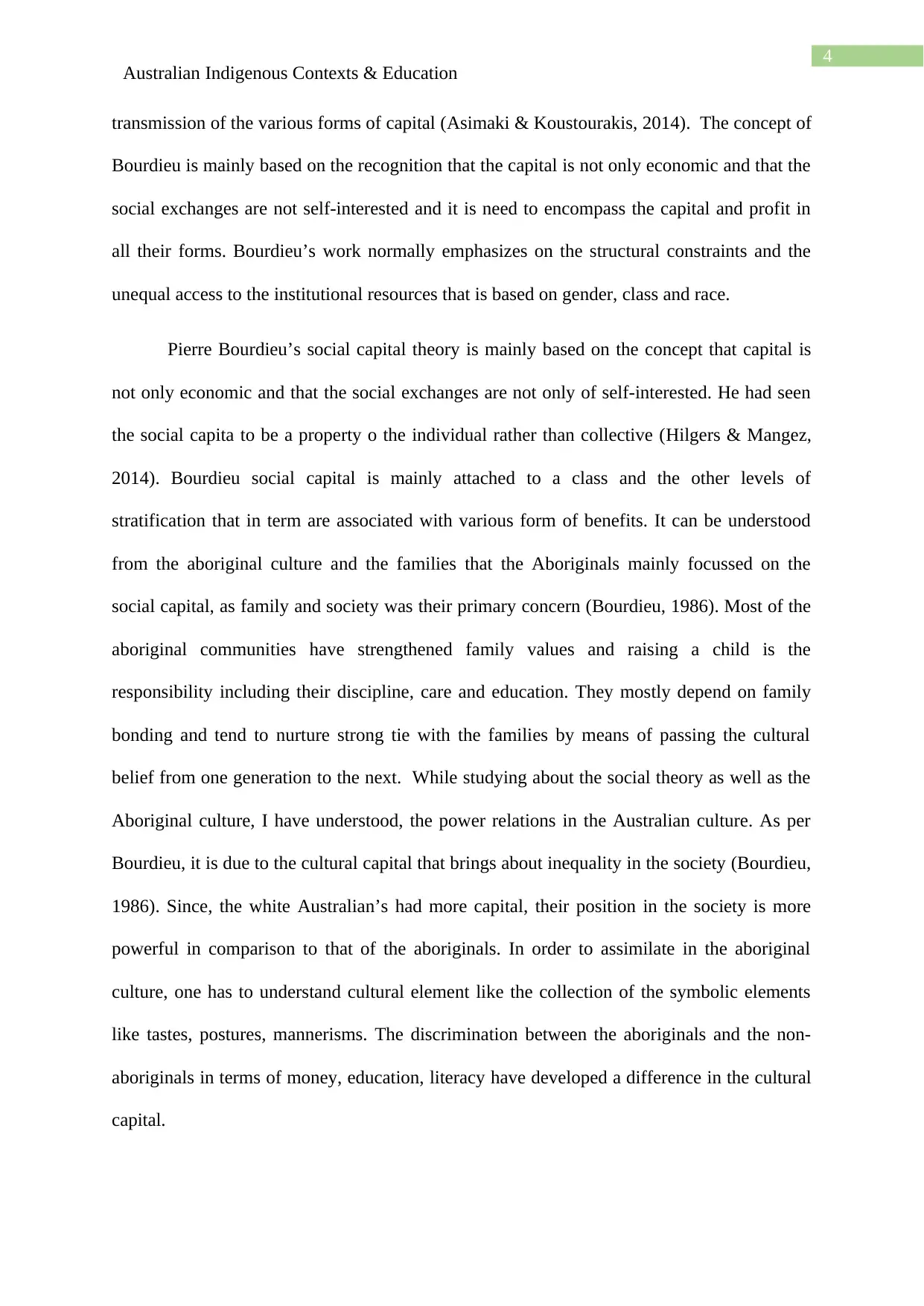
4
Australian Indigenous Contexts & Education
transmission of the various forms of capital (Asimaki & Koustourakis, 2014). The concept of
Bourdieu is mainly based on the recognition that the capital is not only economic and that the
social exchanges are not self-interested and it is need to encompass the capital and profit in
all their forms. Bourdieu’s work normally emphasizes on the structural constraints and the
unequal access to the institutional resources that is based on gender, class and race.
Pierre Bourdieu’s social capital theory is mainly based on the concept that capital is
not only economic and that the social exchanges are not only of self-interested. He had seen
the social capita to be a property o the individual rather than collective (Hilgers & Mangez,
2014). Bourdieu social capital is mainly attached to a class and the other levels of
stratification that in term are associated with various form of benefits. It can be understood
from the aboriginal culture and the families that the Aboriginals mainly focussed on the
social capital, as family and society was their primary concern (Bourdieu, 1986). Most of the
aboriginal communities have strengthened family values and raising a child is the
responsibility including their discipline, care and education. They mostly depend on family
bonding and tend to nurture strong tie with the families by means of passing the cultural
belief from one generation to the next. While studying about the social theory as well as the
Aboriginal culture, I have understood, the power relations in the Australian culture. As per
Bourdieu, it is due to the cultural capital that brings about inequality in the society (Bourdieu,
1986). Since, the white Australian’s had more capital, their position in the society is more
powerful in comparison to that of the aboriginals. In order to assimilate in the aboriginal
culture, one has to understand cultural element like the collection of the symbolic elements
like tastes, postures, mannerisms. The discrimination between the aboriginals and the non-
aboriginals in terms of money, education, literacy have developed a difference in the cultural
capital.
Australian Indigenous Contexts & Education
transmission of the various forms of capital (Asimaki & Koustourakis, 2014). The concept of
Bourdieu is mainly based on the recognition that the capital is not only economic and that the
social exchanges are not self-interested and it is need to encompass the capital and profit in
all their forms. Bourdieu’s work normally emphasizes on the structural constraints and the
unequal access to the institutional resources that is based on gender, class and race.
Pierre Bourdieu’s social capital theory is mainly based on the concept that capital is
not only economic and that the social exchanges are not only of self-interested. He had seen
the social capita to be a property o the individual rather than collective (Hilgers & Mangez,
2014). Bourdieu social capital is mainly attached to a class and the other levels of
stratification that in term are associated with various form of benefits. It can be understood
from the aboriginal culture and the families that the Aboriginals mainly focussed on the
social capital, as family and society was their primary concern (Bourdieu, 1986). Most of the
aboriginal communities have strengthened family values and raising a child is the
responsibility including their discipline, care and education. They mostly depend on family
bonding and tend to nurture strong tie with the families by means of passing the cultural
belief from one generation to the next. While studying about the social theory as well as the
Aboriginal culture, I have understood, the power relations in the Australian culture. As per
Bourdieu, it is due to the cultural capital that brings about inequality in the society (Bourdieu,
1986). Since, the white Australian’s had more capital, their position in the society is more
powerful in comparison to that of the aboriginals. In order to assimilate in the aboriginal
culture, one has to understand cultural element like the collection of the symbolic elements
like tastes, postures, mannerisms. The discrimination between the aboriginals and the non-
aboriginals in terms of money, education, literacy have developed a difference in the cultural
capital.
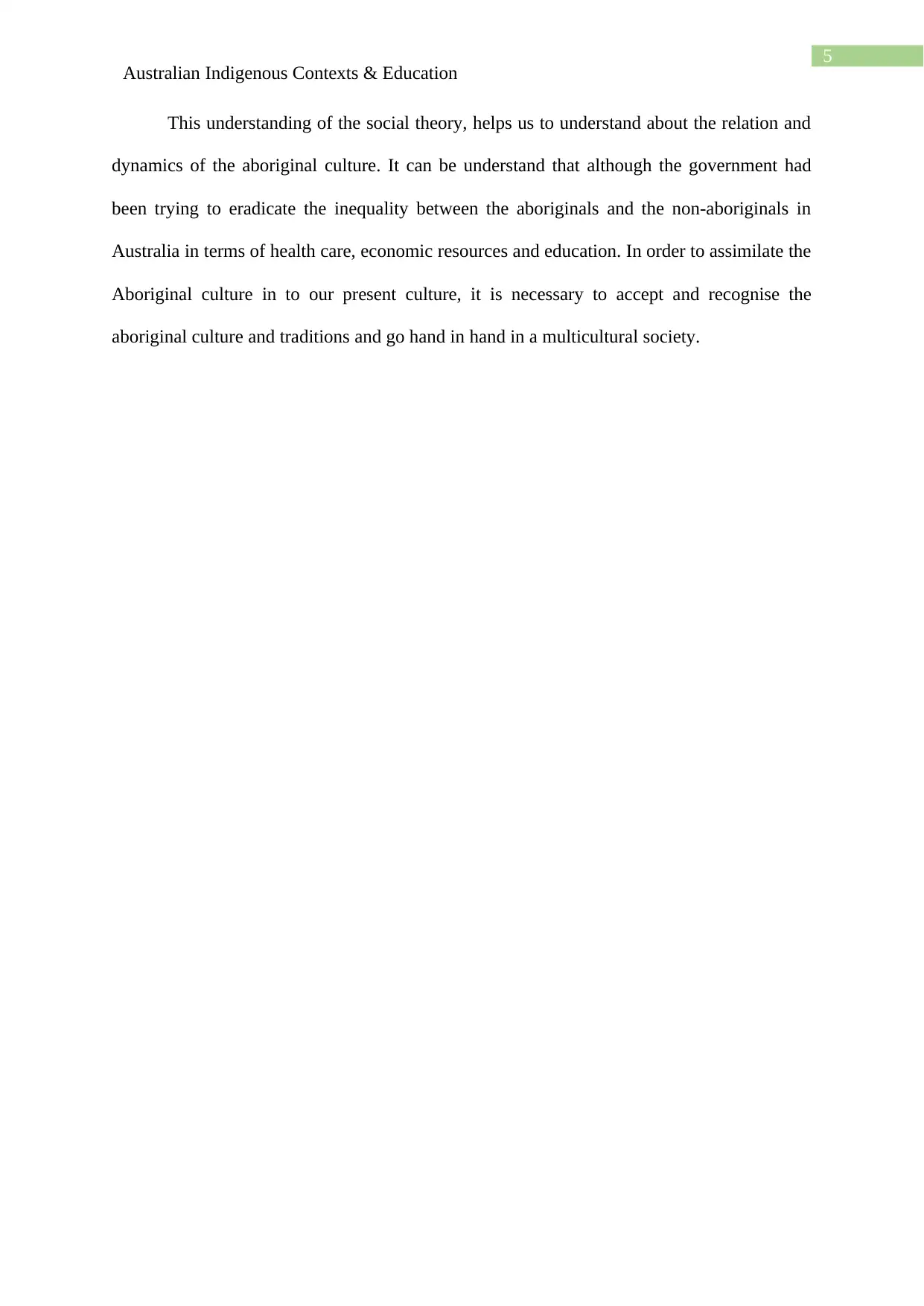
5
Australian Indigenous Contexts & Education
This understanding of the social theory, helps us to understand about the relation and
dynamics of the aboriginal culture. It can be understand that although the government had
been trying to eradicate the inequality between the aboriginals and the non-aboriginals in
Australia in terms of health care, economic resources and education. In order to assimilate the
Aboriginal culture in to our present culture, it is necessary to accept and recognise the
aboriginal culture and traditions and go hand in hand in a multicultural society.
Australian Indigenous Contexts & Education
This understanding of the social theory, helps us to understand about the relation and
dynamics of the aboriginal culture. It can be understand that although the government had
been trying to eradicate the inequality between the aboriginals and the non-aboriginals in
Australia in terms of health care, economic resources and education. In order to assimilate the
Aboriginal culture in to our present culture, it is necessary to accept and recognise the
aboriginal culture and traditions and go hand in hand in a multicultural society.
⊘ This is a preview!⊘
Do you want full access?
Subscribe today to unlock all pages.

Trusted by 1+ million students worldwide
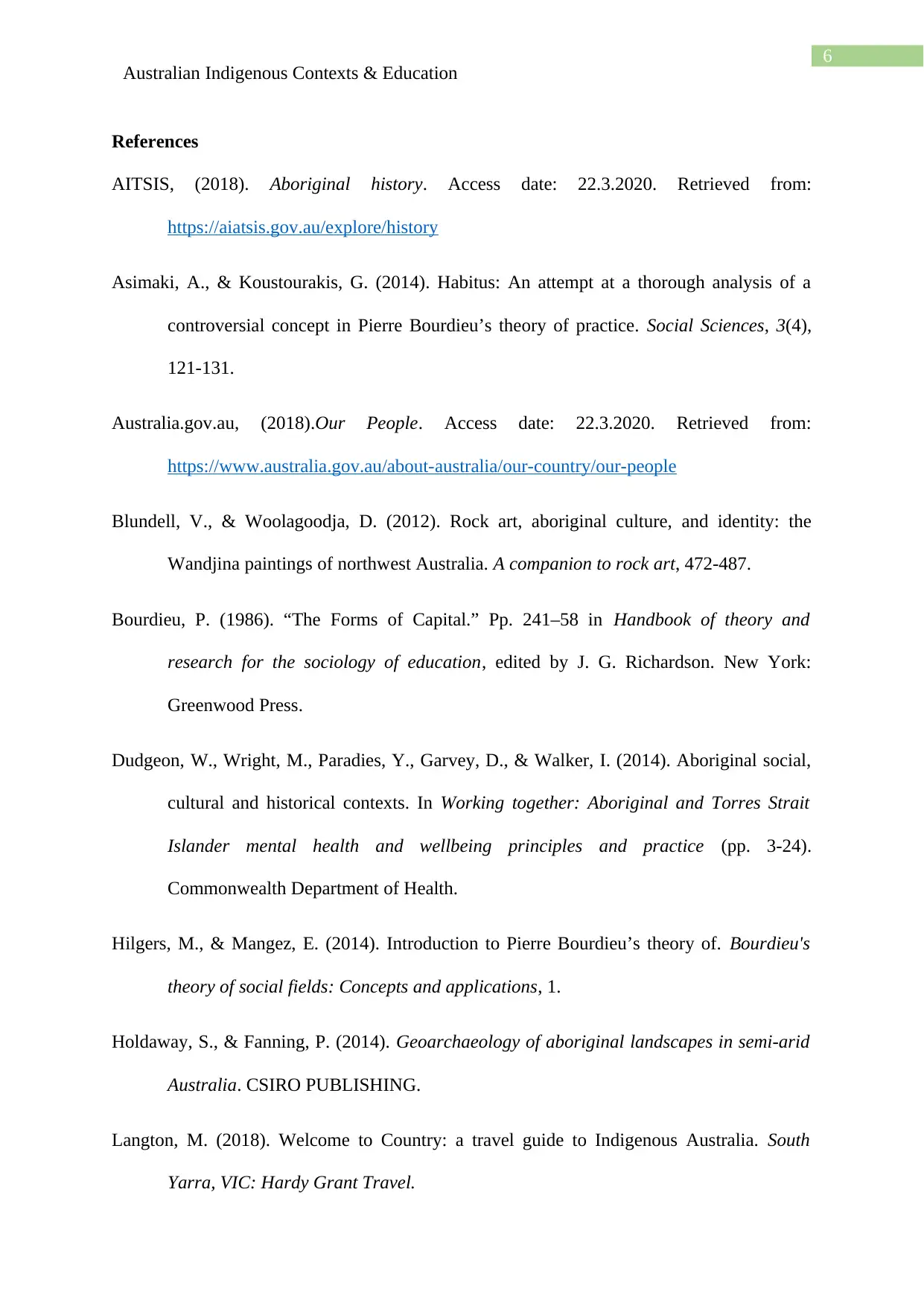
6
Australian Indigenous Contexts & Education
References
AITSIS, (2018). Aboriginal history. Access date: 22.3.2020. Retrieved from:
https://aiatsis.gov.au/explore/history
Asimaki, A., & Koustourakis, G. (2014). Habitus: An attempt at a thorough analysis of a
controversial concept in Pierre Bourdieu’s theory of practice. Social Sciences, 3(4),
121-131.
Australia.gov.au, (2018).Our People. Access date: 22.3.2020. Retrieved from:
https://www.australia.gov.au/about-australia/our-country/our-people
Blundell, V., & Woolagoodja, D. (2012). Rock art, aboriginal culture, and identity: the
Wandjina paintings of northwest Australia. A companion to rock art, 472-487.
Bourdieu, P. (1986). “The Forms of Capital.” Pp. 241–58 in Handbook of theory and
research for the sociology of education, edited by J. G. Richardson. New York:
Greenwood Press.
Dudgeon, W., Wright, M., Paradies, Y., Garvey, D., & Walker, I. (2014). Aboriginal social,
cultural and historical contexts. In Working together: Aboriginal and Torres Strait
Islander mental health and wellbeing principles and practice (pp. 3-24).
Commonwealth Department of Health.
Hilgers, M., & Mangez, E. (2014). Introduction to Pierre Bourdieu’s theory of. Bourdieu's
theory of social fields: Concepts and applications, 1.
Holdaway, S., & Fanning, P. (2014). Geoarchaeology of aboriginal landscapes in semi-arid
Australia. CSIRO PUBLISHING.
Langton, M. (2018). Welcome to Country: a travel guide to Indigenous Australia. South
Yarra, VIC: Hardy Grant Travel.
Australian Indigenous Contexts & Education
References
AITSIS, (2018). Aboriginal history. Access date: 22.3.2020. Retrieved from:
https://aiatsis.gov.au/explore/history
Asimaki, A., & Koustourakis, G. (2014). Habitus: An attempt at a thorough analysis of a
controversial concept in Pierre Bourdieu’s theory of practice. Social Sciences, 3(4),
121-131.
Australia.gov.au, (2018).Our People. Access date: 22.3.2020. Retrieved from:
https://www.australia.gov.au/about-australia/our-country/our-people
Blundell, V., & Woolagoodja, D. (2012). Rock art, aboriginal culture, and identity: the
Wandjina paintings of northwest Australia. A companion to rock art, 472-487.
Bourdieu, P. (1986). “The Forms of Capital.” Pp. 241–58 in Handbook of theory and
research for the sociology of education, edited by J. G. Richardson. New York:
Greenwood Press.
Dudgeon, W., Wright, M., Paradies, Y., Garvey, D., & Walker, I. (2014). Aboriginal social,
cultural and historical contexts. In Working together: Aboriginal and Torres Strait
Islander mental health and wellbeing principles and practice (pp. 3-24).
Commonwealth Department of Health.
Hilgers, M., & Mangez, E. (2014). Introduction to Pierre Bourdieu’s theory of. Bourdieu's
theory of social fields: Concepts and applications, 1.
Holdaway, S., & Fanning, P. (2014). Geoarchaeology of aboriginal landscapes in semi-arid
Australia. CSIRO PUBLISHING.
Langton, M. (2018). Welcome to Country: a travel guide to Indigenous Australia. South
Yarra, VIC: Hardy Grant Travel.
Paraphrase This Document
Need a fresh take? Get an instant paraphrase of this document with our AI Paraphraser
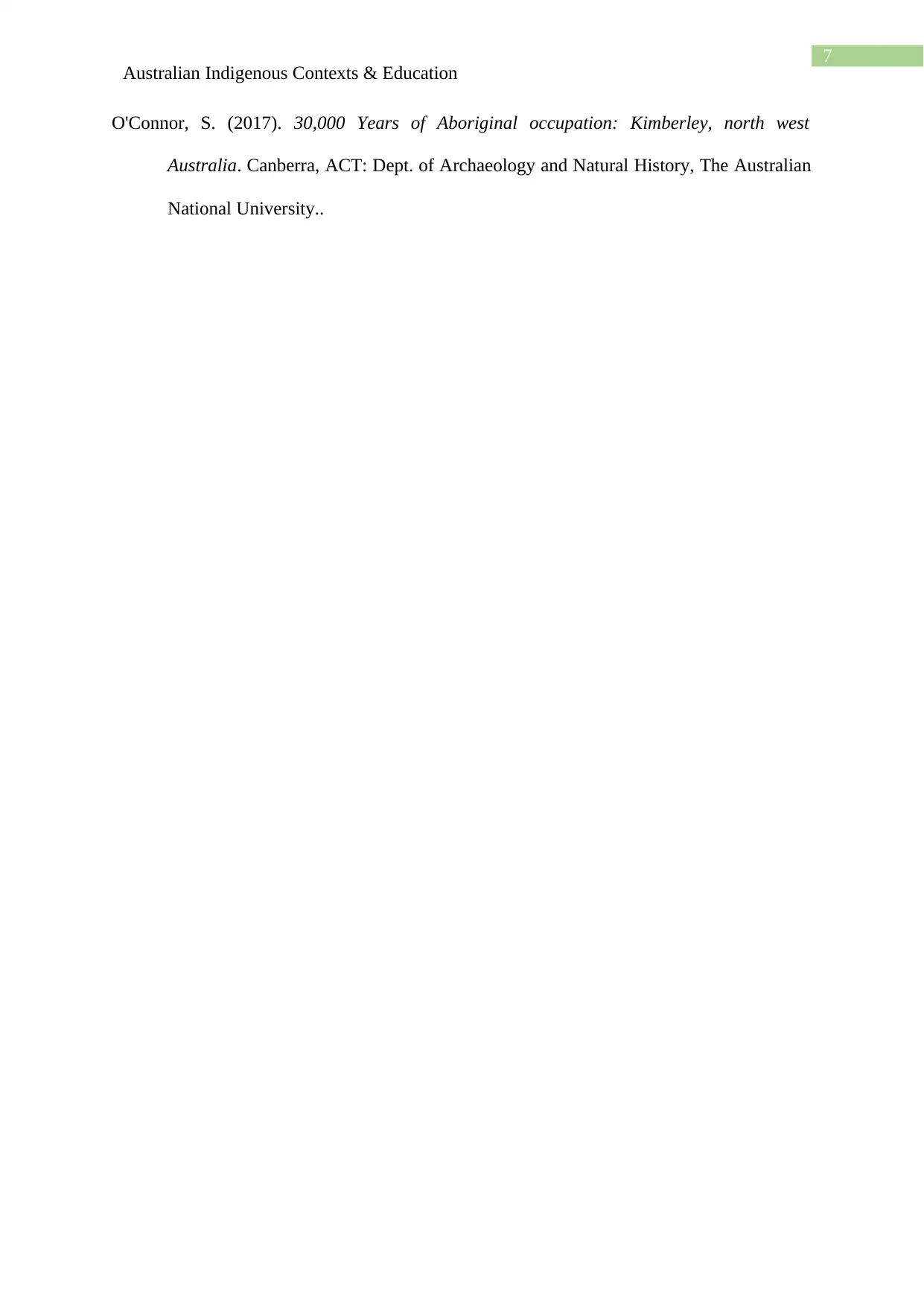
7
Australian Indigenous Contexts & Education
O'Connor, S. (2017). 30,000 Years of Aboriginal occupation: Kimberley, north west
Australia. Canberra, ACT: Dept. of Archaeology and Natural History, The Australian
National University..
Australian Indigenous Contexts & Education
O'Connor, S. (2017). 30,000 Years of Aboriginal occupation: Kimberley, north west
Australia. Canberra, ACT: Dept. of Archaeology and Natural History, The Australian
National University..
1 out of 8
Related Documents
Your All-in-One AI-Powered Toolkit for Academic Success.
+13062052269
info@desklib.com
Available 24*7 on WhatsApp / Email
![[object Object]](/_next/static/media/star-bottom.7253800d.svg)
Unlock your academic potential
Copyright © 2020–2025 A2Z Services. All Rights Reserved. Developed and managed by ZUCOL.





